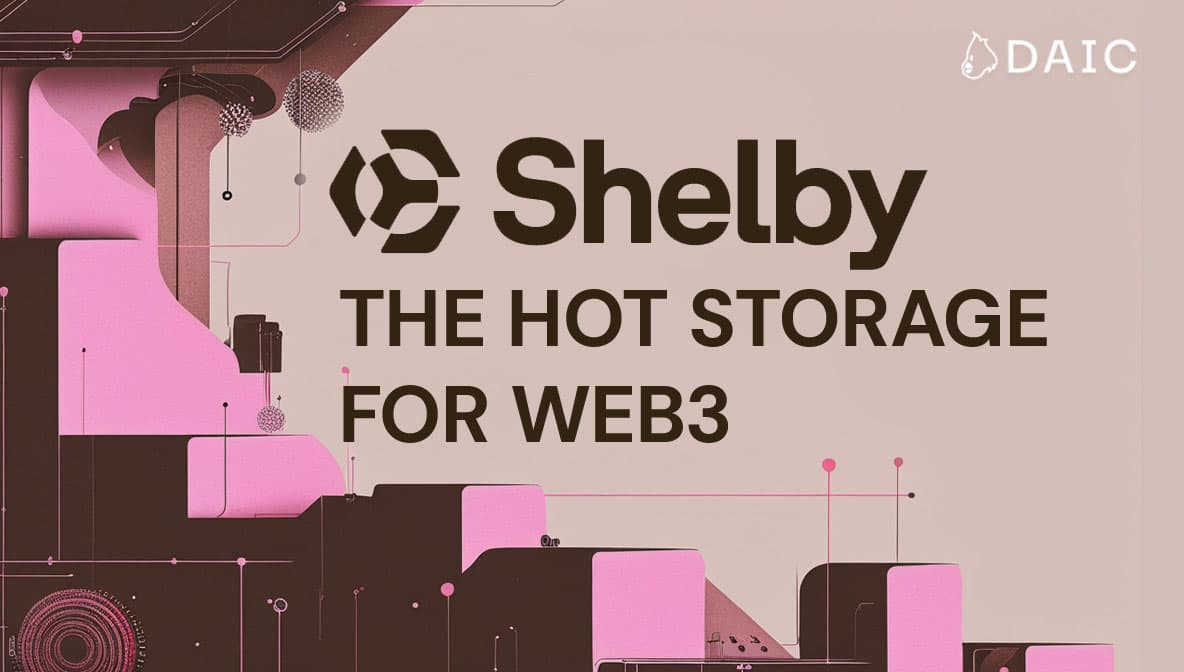Key Takeaways
- Decentralized Data Access: Lava Network enables decentralized RPC and API access across multiple blockchains, ensuring reliability and scalability.
- Cosmos SDK Infrastructure: Built on Cosmos, it leverages a Delegated Proof-of-Stake (DPoS) consensus for secure and efficient data provision.
- Provider Marketplace: Facilitates a competitive marketplace for data providers, improving data quality and uptime.
- Modular Design: Supports new blockchain integrations and APIs through its innovative "specs" system.
- LAVA Token: Powers network transactions, staking, and governance.
Introduction
In the dynamic Web3 landscape, where innovation unfolds at lightning-fast speed, the ability to seamlessly access and interact with blockchain data is paramount. The current landscape, however, is riddled with challenges.
While centralized data providers offer convenience, they also create single points of failure, which can lead to data manipulation and privacy issues. The complexity and resource demands of maintaining independent nodes further increase this centralization, restricting participation and stifling innovation.
Lava Network envisions a world where accessing blockchain data is as simple as browsing the internet, where connection to a decentralized network of nodes, guaranteeing data integrity, reliability, and security. By rethinking the infrastructure for blockchain data access, it aims to unleash a new era of Web3 applications, empowering developers and users to build and engage with a decentralized future.
In this technical deep dive, we will embark on a journey through the inner workings of Lava Network. We will explore its innovative architecture, the algorithms that govern its operation, and the underlying technologies that make it all possible. Whether you're a seasoned blockchain developer or simply curious about the future of Web3, join us as we unravel the complexities and potential of Lava Network.
Addressing the Data Access Bottleneck in Web3
Lava Network is redefining blockchain accessibility by offering a comprehensive solution that streamlines dApp and blockchain interactions. Its modular architecture ensures reliable, scalable, and permissionless access to blockchain data, facilitating seamless communication between decentralized applications and various blockchains.
As the blockchain landscape continues to expand, Lava Network's value proposition becomes increasingly compelling. The platform's unique design, which combines a peer-to-peer protocol with a Cosmos SDK appchain, fosters efficient coordination between data providers, consumers, and validators, ensuring optimal performance across diverse blockchain networks.
Serving as a unified data access layer for Web3, Lava Network consolidates all providers and chains into a single, convenient platform. The platform offers a comprehensive RPC and API solution for any blockchain, engaging providers and freeing developers from the complexities of node management. This strategic approach ensures high uptime, robust data integrity, scalability, privacy, and resistance to censorship.
By enabling seamless integration of applications with a vast network of RPC nodes, the platform empowers developers with automatic request routing to the most suitable provider, thereby significantly improving transaction speed and reliability. This eliminates the need for manual provider selection and offers a diverse range of APIs and chains, thereby significantly enhancing the developer experience. The platform's dynamic adaptability also enables seamless integration with new rollups' RPC modules.
Unlike other providers, Lava's distinctive approach unifies all providers and their APIs within a single platform, offering developers:
- Comprehensive access: A single subscription unlocks a vast array of providers and their APIs.
- Simplified multi-chain management: Effortless multi-chain RPC interaction is achieved through Lava's peer-to-peer SDK.
- Extensive options and adaptability: A wide selection of APIs and chains is available, with the ability for community contributions to expand support for new APIs based on demand.
- Flexibility and autonomy: Open-source tools eliminate vendor lock-in concerns.
- Reliable performance: Scalability and network redundancy ensure consistent performance.
- Optimized routing: Intelligent request routing directs traffic to the fastest and most dependable providers available.
Moreover, Lava Network introduced the innovative feature called "specs," a blockchain primitive that allows new chains, APIs, and data services to be added to the underlying protocol without permission. This fosters a unified foundation for innovation and reliability within the increasingly fragmented multi-chain landscape, ultimately benefiting both developers and users.
Following a successful testnet phase with over 4 million wallets and with millions of requests processed daily across 30+ networks, Lava Network recently launched its public Mainnet. This milestone not only marks a significant achievement for the project but also opens up a world of possibilities for those seeking to build and interact with decentralized applications in a secure and efficient manner.
Lava Network Deep Dive
Lava Network is an open-source protocol that functions as a marketplace for blockchain RPC and APIs. It empowers decentralized applications (dApps) and indexers with the most reliable access to these essential services by intelligently routing requests through a globally distributed network of node providers.
At its core, Lava is a Cosmos-based Delegated Proof-of-Stake (dPoS) chain that facilitates seamless peer-to-peer connections between RPC providers and consumers. This decentralized approach ensures resilience, security, and optimal performance.
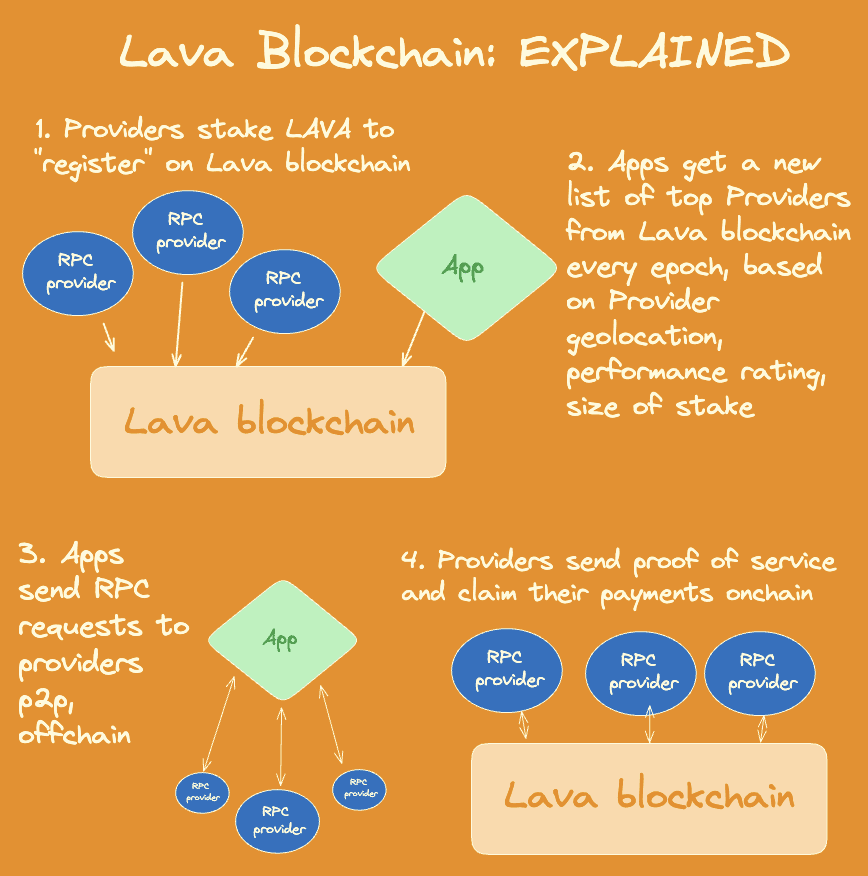
Lava Network operates as a vibrant ecosystem with diverse stakeholders. Champions introduce new APIs and chains through "specifications," while chains and sponsors incentivize data providers by contributing tokens to Lava's Incentivized RPC pools. Providers, in turn, stake LAVA and join the network, offering their node services with economic guarantees of quality and integrity. All data exchanged between providers and consumers is carried within “relays”, which consist of both data and metadata.
Consumers, including dApps, wallets, and indexers, tap into Lava's resources for data access, with the option to enhance their usage limits through LAVA subscriptions. Meanwhile, delegators and validators play a crucial role in network security by staking their LAVA, thereby increasing the frequency with which quality providers and validators are rewarded.
The Lava Network ecosystem thrives on a dynamic incentive structure that rewards participation at every level:
- Validators: Guardians of the network's security, validators run full Lava nodes to validate transactions, resolve conflicts, and participate in on-chain governance decisions. Their dedication ensures the integrity and stability of the Lava blockchain.
- Delegators: By staking their LAVA tokens on reputable providers, delegators contribute to network security and share in the providers' rewards. This collaborative model fosters trust and encourages provider accountability.
- Providers: As the backbone of Lava Network, providers operate nodes and deliver essential data services within a competitive landscape. Their rewards are directly linked to the quality of service they provide, incentivizing continuous improvement and excellence.
- Consumers: Comprising developers, dApps, web applications, and APIs, consumers rely on Lava Network for efficient and reliable access to RPC and other data services. Their demand drives the network's growth and provides a continuous feedback loop for improvement.
- Champions: These innovators define "specs," blueprints that pave the way for the addition of new data infrastructure types to the network, such as RPC, indexing, and oracles. By contributing to the network's expansion and functionality, champions play a crucial role in its evolution.
This dynamic combination of incentives creates a self-sustaining ecosystem where all participants benefit from active engagement, fostering a collaborative and thriving community within the Lava Network.
The way Lava works
The network's functionality is coordinated across three distinct phases, each playing a key role in robust data delivery.
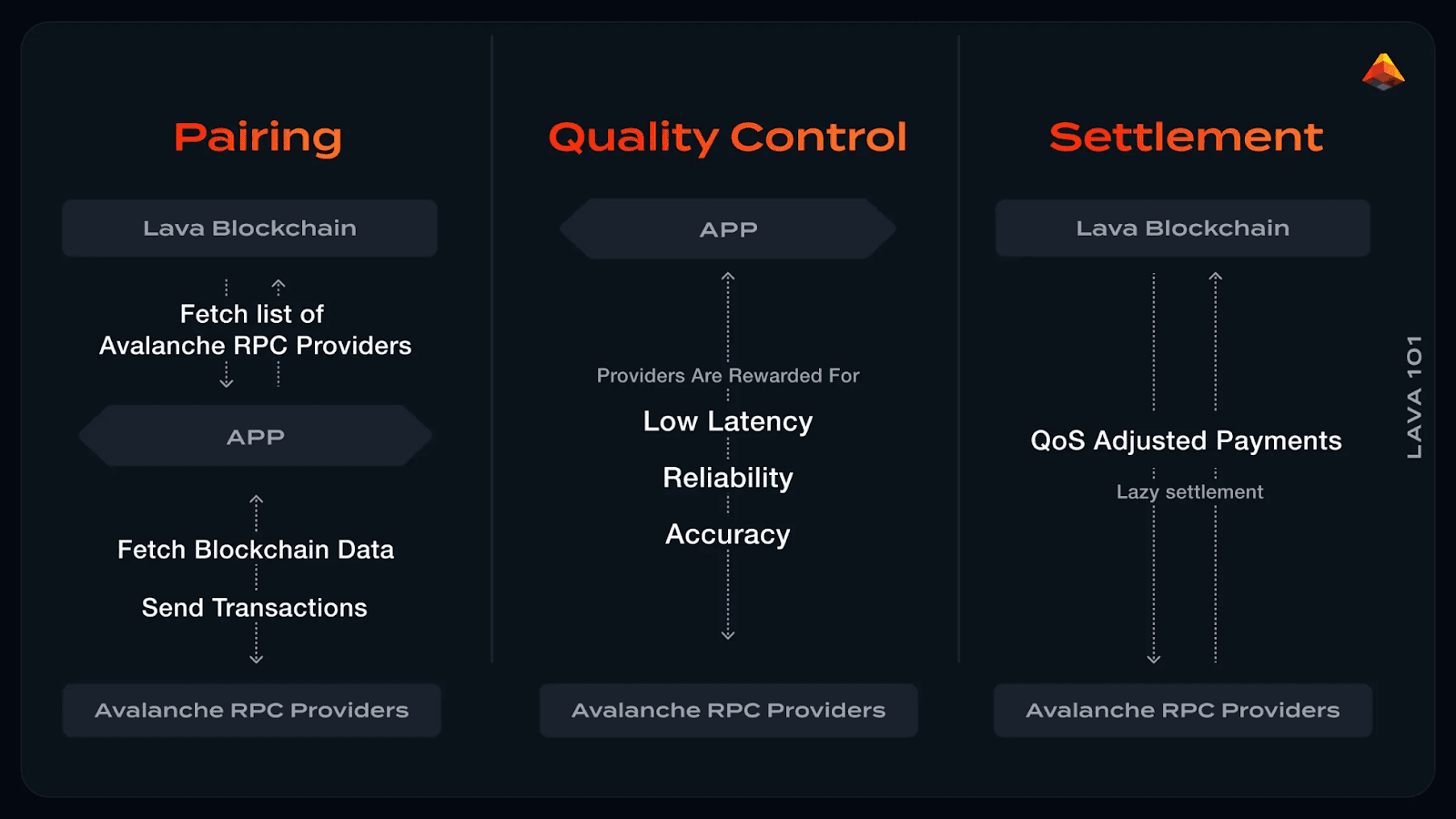
On-chain Pairing Mechanism
Lava Network's Pairing mechanism is designed to optimize both performance and user experience by smartly linking RPC consumers with the best-suited providers. This system evaluates several factors, such as provider stake, geographic location, and past performance, to ensure optimal matches.
At the heart of this mechanism is the Pairing List, a dynamic set of eligible providers that refreshes at the start of each epoch on the Lava blockchain. The update frequency is adjustable through on-chain governance, allowing the system to adapt as network conditions change.
When consumers request access, they specify their preferred blockchain network and region, which the system uses to generate an appropriate Pairing List.
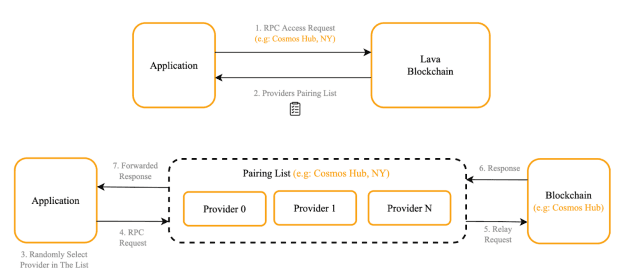
To be included in the Pairing List, providers must stake LAVA tokens, signifying their commitment and serving as a guarantee of their performance. Once providers are active, their service performance is monitored and influences their chances of being selected for future pairings. Although LAVA tokens are the network's currency, the providers' workload is quantified in Compute Units (CUs), ensuring rewards match the computational resources used.
Consumers can easily access RPC services via Lava's Gateway, SDK, or Server Kit, which simplifies the pairing process, allowing to concentrate on their primary tasks.
In essence, the Pairing algorithm exemplifies the platform's dedication to delivering a dependable, efficient, and user-friendly blockchain data access service. By expertly matching consumers with the best providers, Lava Network ensures a smooth and high-performance experience for everyone involved.
Quality Control
Lava Network prioritizes data accuracy and service quality through a comprehensive quality control mechanism. This multi-faceted approach involves both off-chain peer-to-peer interactions and on-chain verification processes.
Consumers continuously evaluate provider performance based on latency, availability, and data freshness, submitting signed quality-of-service (QoS) reports to the blockchain. These reports are then integrated into a provider's overall on-chain score, directly influencing their rewards. This creates a powerful incentive for providers to maintain high standards, as their earnings are directly tied to their performance.
To further ensure data accuracy, Lava Network employs cryptographic signatures and data reliability checks. Both provider-funded and client-funded data reliability methods are in place to verify the authenticity of data. In the event of discrepancies, a consensus-based "Honest Majority" protocol among validators determines the correct data, with any malicious or faulty providers facing penalties.
Lava's commitment to quality is underscored by its incentivization scheme. Providers are rewarded for delivering excellent service with increased client pairings and higher payments, while underperformance can lead to scoring penalties, token burning, and even exclusion from the network. The three key metrics of availability, latency, and freshness are meticulously tracked, providing a comprehensive assessment of each provider's performance. This data-driven approach ensures that only the most performant and reliable providers are consistently selected to service requests.
This holistic quality control system not only guarantees the accuracy and reliability of data within the Lava Network but also fosters a competitive environment where providers are incentivized to constantly improve their services, ultimately benefiting the entire ecosystem.
Settlement
Lava Network streamlines the provider payment process through its innovative "Lazy Settlement" system. This approach allows providers to consolidate multiple payment requests into a single transaction, cutting down on transaction fees and enhancing network efficiency. Even if a provider temporarily loses their connection to the blockchain, they can still retroactively claim their earned rewards once they reconnect.
Looking ahead, Lava Network is preparing to introduce an "Emergency Mode" to ensure that services remain uninterrupted and providers continue to receive their rewards, even if the Lava blockchain itself faces downtime. This feature will enable consumers to keep accessing services using their most recent pairing list, while providers will have the ability to retroactively claim their rewards once the blockchain is operational again.
Economic Incentives
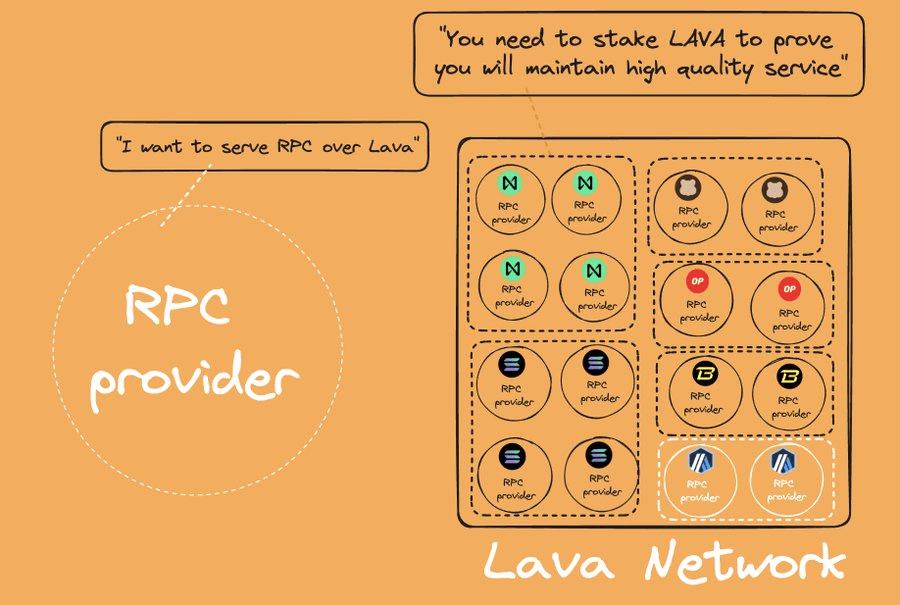
Lava Network has developed a strong economic model that builds a sustainable and thriving ecosystem for all participants. This is powered by the native LAVA token, which incentivize active participation while promoting high-quality service provision and network security.
At the core of this model is a Reward System where node operators are rewarded in LAVA tokens for successfully satisfying data requests. The volume of earned tokens is directly proportional to the size and complexity of tasks done, incentivizing providers to deliver reliable and efficient services.
To further incentivize quality service provision, validators and RPC providers stake LAVA tokes to be able to participate in the network governance and serve high-value requests. This creates a performance-securing bond in which providers have a stake in maintaining good levels of service.
LAVA token holders enhance the Lava Network's security and stability by delegating tokens to validators, who maintain the blockchain's integrity. In return, validators share a portion of their rewards with delegators. Lava's innovative restaking feature allows token holders to delegate their LAVA to RPC providers, maximizing rewards and further strengthening the network.
For ensuring data integrity and reliability, Lava Network uses slashing mechanisms that impose penalties on providers upon failure to provide data that is either accurate or available. This measure of accountability does not at all encourage any actions that would spoil the network's highly regarded reputation and ensures that users receive trustworthy information.
To attract a wider range of providers, Lava Network offers public RPC pools where chains and sponsors can deposit tokens as additional incentives. These pools serve as a powerful motivator for providers to join the network and contribute their resources, thereby enhancing the network's overall capacity and capabilities.
The network also implements a subscription-based revenue model, allowing developers and other consumers to pay for guaranteed data access using LAVA tokens. This creates a reliable stream of revenues for the data providers, further incentivizing their participation and encouraging a long-run commitment to the network.
In addition, rewards can be dynamically adjusted based on the state of the network and specific data types. This adaptability aligns incentives to assure that requirements of a dynamically changing network are met, and a good balance maintained in the ecosystem.
Specifications: Modular Key for Blockchain Adaptability
Modularity at the best — Lava Network transforms into a dynamic and responsive ecosystem that rapidly adapts to the ever-changing needs facing the blockchain landscape.

At the very core of Lava Network's flexibility is its genius "Specs" system. Specs (Specifications) are modular blueprints, JSON files that outline the requirements for data providers to offer specific APIs, and enabling a seamless expansion beyond basic RPC services to encompass indexing, rich APIs, archival support, and more.
For example, when a new blockchain is integrated, it identifies within the spec file the list of available RPC APIs, the minimum stake required, and other core configurations. Similarly, consumers could also contribute specs for Rich APIs with details of the accepted calls to the nodes.
The real power of Specs lies in the fact that it is open source, with a permissionless contribution model. Anyone can create a new Spec and propose it. This creates a thriving developer community able to contribute to the growth of the network and ensures it stays up-to-date with technological innovation. One could think of it as an app store model where developers come up with new innovative services, while the platform provides an easy user interface for discovery.
Through this system, Lava Network has already worked with Subsquid in support of their subgraphs, solidifying resilience, speed, and decentralization of API services. It is an exemplary case of the power of that modular approach, showing how Lava Network envisions ease of use for developers in an unparalleled way, simplifying their entry into the vast dynamic world of Web3.
Subscription Plans: User-Friendly Blockchain Access
Lava Network provides flexible subscription plans that give consumers seamless access to the services. In all, the subscription plans would run from 1-12 months, providing a predictable and cost-effective way to use the resources available within the network. Each plan indicates a monthly cost alongside a corresponding number of Compute Units, which determines how much data a consumer may access.
Subscriptions offer quite a number of advantages against pay-as-you-go systems: they let Lava have a self-sustaining ecosystem by building long-term relationships between consumers and providers, thus ensuring that providers will be able to count on continuous revenue while consumers can be certain of reliable and continuing access to the services. In addition, Lava Network offers attractive discounts for yearly subscriptions, thus further tightening mutually beneficial cooperation between users and the platform.
Another flexible aspect of Lava's subscription model is that consumers can create several projects under their subscriptions, where each will have different policies and usage keys. It adds flexibility for more advanced use cases of customization and better management of resources. Besides, it runs a governance-based system to maintain the dynamics of subscription plans according to market dynamics to ensure competitive pricing and be responsive to dynamic user needs.
Basically, the subscription model to Lava Network is user-friendly, viable, and adaptive. The variety of plans, coupled with handsome discounts for customers and providers, make it a win-win proposition for all concerned.
Build Whatever, Wherever
Lava's SDKs empower developers to build decentralized applications with seamless access to blockchain data, regardless of the specific chain or API. Whether you're exploring cross-chain functionalities or simply seeking a streamlined multi-chain RPC setup, Lava's tools simplify the process and enable rapid development.
The Lava SDK, a JavaScript/TypeScript library, is the first of its kind: a decentralized, peer-to-peer blockchain RPC solution. It abstracts away the complexities of multi-chain interactions, allowing developers to add new chains with just a few lines of code. This empowers them to build cross-chain applications and tap into the full potential of the Lava ecosystem.
For those who prefer a more visual approach, Lava Gateway provides a user-friendly web platform for instant access to blockchain data. Built upon the Lava Server Kit, the Gateway offers a hosted entry point for RPC access through the Lava Network. It features an intuitive interface that allows for effortless management of Web3 APIs directly within your browser.
Lava's SDK and Gateway work in tandem, offering developers the best of both worlds: full decentralization and control with the SDK, coupled with the simplicity and ease of use of the Gateway's UI for API management.
As a reference implementation of the Lava protocol, the SDK natively supports all chains and APIs integrated into the network. This means developers gain rapid access to new chains and APIs, thanks to the active contributions of Lava node runners and the open-source community.
Lava Network aims to accelerate blockchain and rollup deployment by swiftly establishing a robust network of RPC and indexing providers. By making any API faster, more resilient, and cost-effective, Lava simplifies multi-chain data infrastructure and eliminates the fragmentation prevalent in today's L2 and rollup landscape. Ultimately, Lava creates sustainable incentives for long-term node decentralization, fostering a healthier and more robust blockchain ecosystem.
Beyond Boundaries: Lava Network's Mainnet and Future Vision
Lava Network recently took a bold step forward by launching its Mainnet and LAVA token with a unique, DEX-first approach aimed at maximizing decentralization and community participation. This pioneering approach, which involved a market-derived FDV and a focused airdrop to 70,000 wallets, marked a significant departure from traditional token launch strategies. While the community response has been mixed due to the novelty of this approach, Lava Network remains committed to its long-term vision and views this launch as a valuable learning experience for the broader blockchain community.
Lava's decision to launch directly on Uniswap V3 was driven by a desire to avoid artificially inflated valuations and allow the market to determine the true value of the LAVA token. Additionally, the choice of Arbitrum as the launch venue aimed to reach the widest possible audience and ensure maximum decentralization. While this decision caused some initial confusion, it underscores Lava's dedication to inclusivity and transparency.
Moving forward, Lava Network has a clear roadmap for future development. This includes ongoing protocol enhancements, the launch of incentive pools on Mainnet, delegation programs, bug and feature bounties, and a detailed roadmap update. Grants will also be available to support innovative projects within the Lava ecosystem. Beyond RPC, Lava Network is set to evolve into a comprehensive data access solution, supporting a wider array of services such as indexing, oracles, and even language models (LLMs).
Central to Lava Network's mission is the creation of a sustainable and robust data infrastructure for the crypto ecosystem. This focus on long-term value creation over short-term gains is evident in their emphasis on building a protocol that genuinely serves the needs of users and developers.
Lava Network's testnet phase garnered significant industry recognition, with leading entities like Google Cloud and other prominent providers actively running nodes on the network. This early adoption underscores the platform's potential to revolutionize blockchain infrastructure.
Strategic partnerships further solidify Lava's commitment to widespread adoption and interoperability. Collaborations with top-tier ecosystems such as NEAR, Avail, Starknet, and Filecoin highlight the network's growing influence and its ability to foster cross-chain synergies. These partnerships are reinforced by the allocation of nearly 5 million tokens from these chains to incentivize pools on Lava's Mainnet, creating a self-sustaining cycle of growth and adoption.
Lava Network's Use Cases
Lava Network's pioneering decentralized data access platform opens up a world of possibilities across various blockchain use cases, far beyond its core strength in providing reliable RPC access.
Its ability to deliver real-time, accurate blockchain data ensures that DeFi protocols can execute transactions and smart contracts seamlessly, even during periods of high network congestion. This translates to a superior user experience with faster transaction confirmations and minimized risk of failed transactions.
For example, a decentralized exchange built on top of Lava Network can leverage its fast and reliable RPC access to execute trades with low slippage and latency. The same goes for lending and borrowing platforms, which can also rely on the accurate data feeds from Lava to manage their collateralization ratios and trigger liquidations effectively. In such a way that the stability of the platform remains intact even under extremely volatile market conditions.
Lava Network's decentralized infrastructure is also well-suited to support NFT marketplaces and platforms. Its capacity to handle large volumes of data requests efficiently allows for smooth browsing and transactions of NFTs. In addition, Lava's mechanisms for data verification guarantee the origin and provenance of NFTs, enabling trust and confidence within the marketplace.
Beyond DeFi and NFT, Lava Network's functionality extends into a myriad of other blockchain use cases. For instance, in the gaming industry, Lava's real-time data access could enable the development of more responsive and engaging games. In the case of supply chain space, tamper-proof data storage and retrieval features within Lava can offer end-to-end visibility and traceability to enhance transparency and efficiency. More importantly, the potential of Lava being integrated with large language models and AI will redefine the way data analytics and decision-making happen within the blockchain ecosystem.
The possibilities literally are endless. As Lava Network continues to evolve and expand its capabilities, its services will span across diverse industries and use cases, driving innovation and pushing the boundaries of what's possible in the decentralized world.
Conclusion
In summary, Lava Network is a holistic, adaptive solution to Web3 RPC access challenges. Its blend of decentralization, security, and flexibility gives it a unique edge over any previous solution.
By creating an environment where node operators can efficiently and securely monetize their services, while allowing them to compete with centralized providers on quality, Lava has created a very special value proposition within the blockchain infrastructure landscape.
Although several approaches are likely to be used in the process of finding optimal Web3 RPC solutions, Lava Network's model is currently representative of a promising and effective response to the present challenges.
The information provided by DAIC, including but not limited to research, analysis, data, or other content, is offered solely for informational purposes and does not constitute investment advice, financial advice, trading advice, or any other type of advice. DAIC does not recommend the purchase, sale, or holding of any cryptocurrency or other investment.

